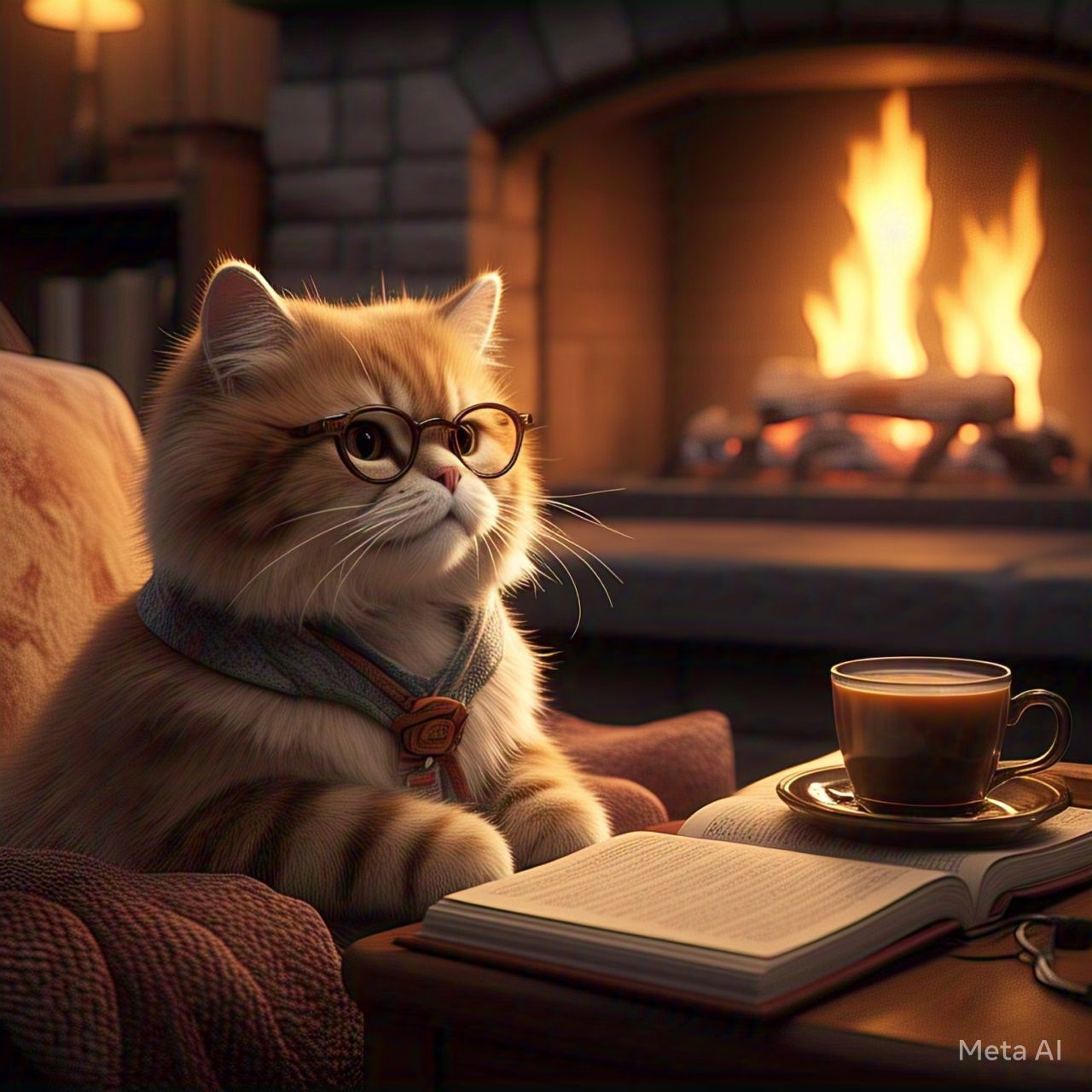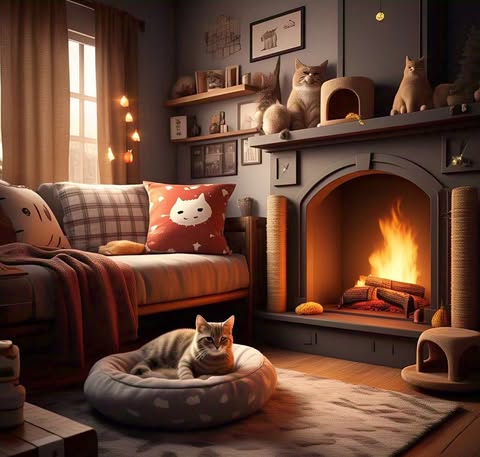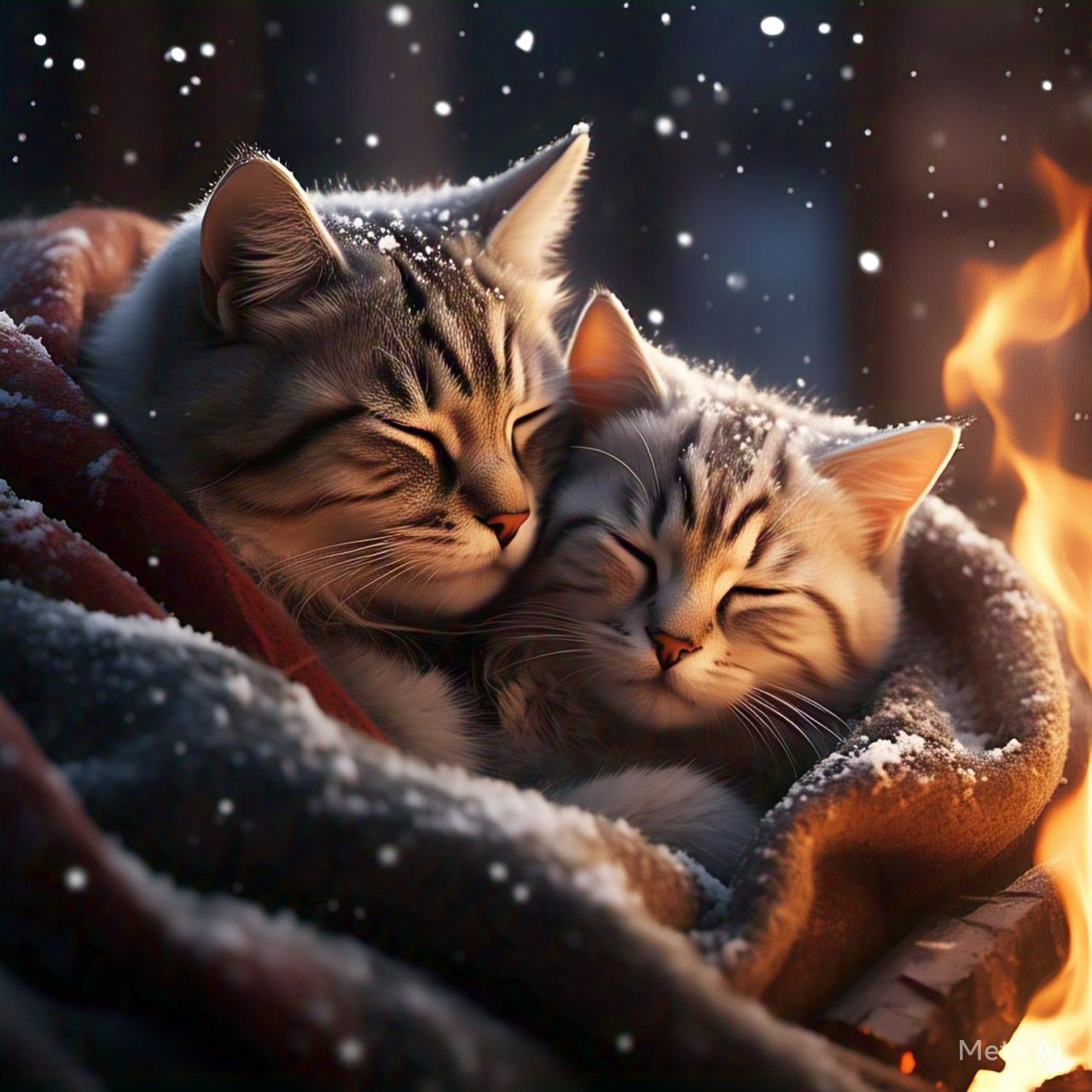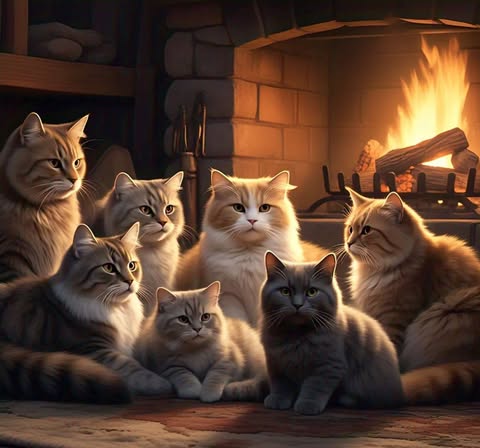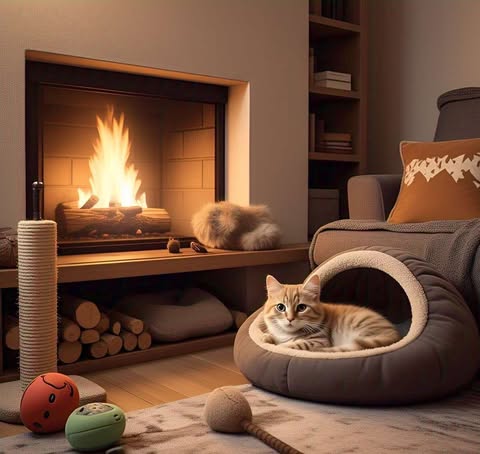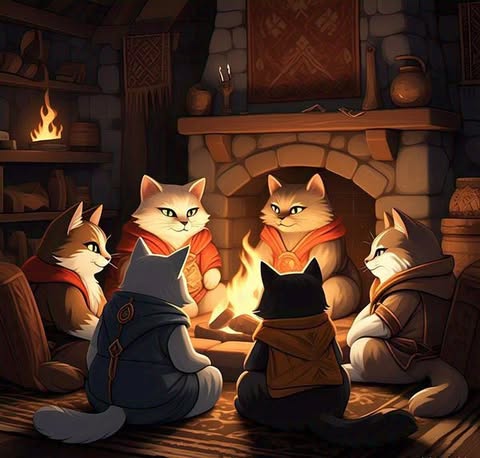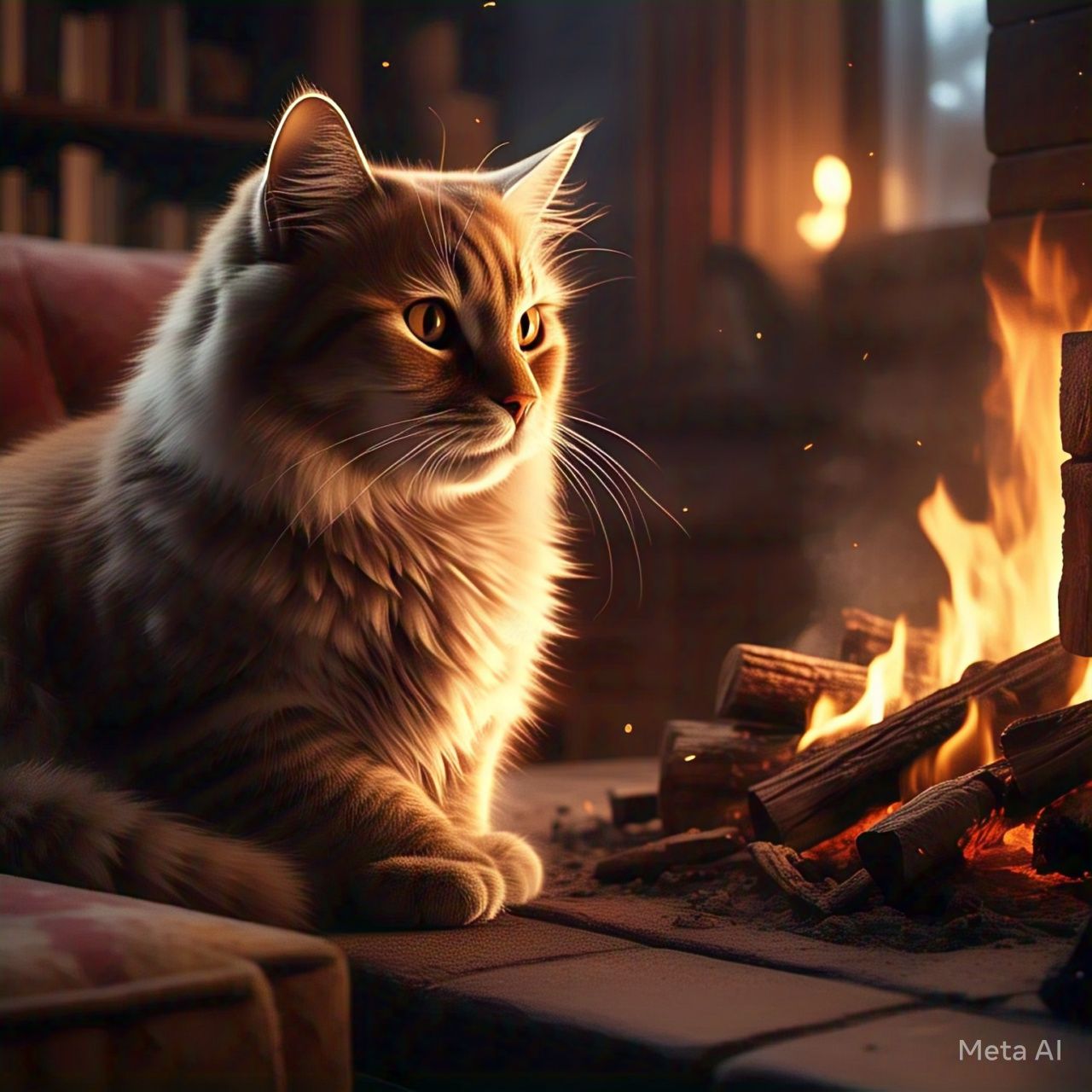Planning
Crafting a Cozy Winter Retreat for Your Cat
As winter settles in with its chilly winds and frosty mornings, pet owners often seek ways to ensure their feline companions remain comfortable and content. Cats, with their love for warmth and quiet corners, thrive in spaces designed to cater to their instincts. A fireside nook offers the perfect blend of heat, softness, and security, creating a haven where a cat can curl up and relax. This article explores the process of building an ideal fireside nook, beginning with careful planning to meet a cat’s unique needs. By considering their preferences and behaviors, anyone can transform a simple corner into a winter sanctuary that brings joy to both the cat and its owner.
Creating such a space requires more than tossing a blanket by the fireplace. It involves understanding what makes a cat feel safe and pampered, from the texture of the bedding to the nook’s location. Thoughtful design ensures the nook becomes a favorite spot, encouraging the cat to spend hours lounging in blissful comfort. This first part sets the stage by delving into the planning phase, offering insights into why a fireside nook matters and how to start shaping one that suits any home.
Why a Fireside Nook Appeals to Cats
Cats gravitate toward warmth like moths to a flame, a trait rooted in their biology. Their ancestors, roaming deserts and savannas, sought sunny patches to rest, and modern house cats carry that instinct. A fireside nook taps into this natural desire, providing a toasty environment that soothes their muscles and calms their minds. Beyond heat, cats crave spaces that feel enclosed yet accessible, allowing them to observe their surroundings while feeling protected. A nook by the fire offers both, blending the allure of a glowing hearth with the security of a cozy retreat.
The appeal also lies in routine. Cats thrive on predictability, and a dedicated nook becomes a familiar place where they can retreat daily. Unlike a random cushion or sofa, a purpose-built nook signals to the cat that this spot belongs to them, reinforcing their sense of ownership. Owners who invest time in crafting this space often notice their cats becoming more relaxed, spending less time hiding under furniture and more time basking in their new favorite area.
Assessing Your Space for the Nook
Before gathering materials or sketching designs, evaluating the home’s layout is essential. Not every fireplace is suited for a cat nook, and choosing the right spot requires careful thought. The area should be close enough to the fire to radiate warmth but far enough to avoid sparks or excessive heat. A corner within two to four feet of the hearth often works best, offering a balance of coziness and safety.
Consider the room’s traffic flow as well. Cats prefer quiet areas where they won’t be disturbed by footsteps or loud voices. A bustling living room might not suit a skittish cat, while a quieter den could be ideal. Observing the cat’s current habits can guide this decision—where do they nap most often? Do they avoid certain areas? These clues reveal their comfort zones, helping pinpoint a location they’re likely to embrace.
The size of the space matters too. A nook doesn’t need to be large, but it should accommodate the cat’s ability to stretch out or curl up as they please. Measuring the available area ensures the nook fits without crowding the room. If the fireplace is in a cramped spot, creative solutions like a wall-mounted shelf or a compact pet bed can maximize space while keeping the nook functional.
Understanding Your Cat’s Preferences
Every cat is unique, with quirks that shape their ideal environment. Some adore plush surfaces, while others prefer smooth fabrics. One might love high perches, while another stays grounded. Watching how the cat interacts with their surroundings provides valuable insight. For instance, a cat that burrows under blankets might enjoy a nook with a hooded bed, while one that sprawls on tile floors could favor a flat, cushioned mat.
Age and health play a role as well. Older cats with stiff joints benefit from low, padded nooks that don’t require jumping. Cats with respiratory issues might need a spot farther from the fire to avoid smoke or dry air. Even personality matters—a bold cat might love a nook in the room’s center, while a shy one prefers a tucked-away corner. Taking time to study these traits ensures the nook aligns with the cat’s needs, increasing the chances they’ll use it regularly.
Gathering this information doesn’t require guesswork. Owners can experiment by placing temporary items, like a folded towel or cardboard box, near the fireplace to see how the cat responds. These tests reveal preferences for height, texture, and proximity to the fire, laying the groundwork for a nook tailored to the cat’s desires.
Planning the Nook’s Design
With the location chosen and the cat’s preferences clear, sketching a plan brings the nook to life. This step involves deciding the nook’s shape, size, and features. A simple design might include a cushioned base with a low rim for easy access, while a more elaborate one could feature a canopy or built-in scratching post. The goal is to balance aesthetics with functionality, creating a nook that blends into the home while serving the cat’s needs.
Materials are a key consideration. The base should be sturdy, able to withstand a cat’s weight and occasional clawing. Wood or reinforced cardboard works well, covered with soft, washable fabrics like fleece or cotton. Avoid materials that trap heat excessively, as the nook will already be warm from the fire. Insulation, like a thin foam layer, can add comfort without overheating.
Safety can’t be overlooked. The nook must stay stable, even if the cat leaps onto it. Anchoring it to the floor or a nearby wall prevents tipping. Fire-resistant fabrics are a smart choice, reducing risks from stray embers. If the fireplace is gas-powered, ensuring proper ventilation keeps the air safe for the cat to breathe.
Budget plays a part too. A nook can be as affordable as a DIY project using repurposed items or as luxurious as a custom-built piece. Setting a spending limit early helps narrow choices without sacrificing quality. For those on a tight budget, thrift stores or online marketplaces offer affordable materials that can be transformed with a little creativity.
Incorporating Sensory Elements
Cats rely on their senses to navigate the world, and a fireside nook should engage them. Texture is a starting point—soft surfaces invite lounging, while a slightly rough patch, like a sisal mat, encourages scratching. Layering different fabrics creates variety, letting the cat choose what feels best on any given day.
Scent matters more than many realize. Cats mark their territory with their own scent, so including a familiar item, like a worn blanket, makes the nook feel like home. Avoid strong cleaners or artificial fragrances when washing materials, as these can deter a cat from settling in. Natural, mild soaps preserve the nook’s appeal.
Visual stimulation adds another layer. Positioning the nook to offer a view of the fire’s glow satisfies a cat’s curiosity without overwhelming them. If the nook faces a window, they might enjoy watching snowflakes or passing birds, keeping their minds engaged. The key is subtlety—too much activity can make the space feel chaotic rather than calming.
Setting a Timeline for Completion
Building a fireside nook doesn’t happen overnight, especially for those crafting it from scratch. Estimating how long the project will take keeps it manageable. A simple nook, using store-bought items, might take a weekend, while a custom design could span a couple of weeks. Breaking the process into steps—gathering materials, assembling the base, adding cushions—prevents overwhelm.
Winter’s approach adds urgency, but rushing risks mistakes. Starting early ensures the nook is ready before the coldest days hit. For those less crafty, buying a pre-made pet bed and customizing it with personal touches can save time without sacrificing thoughtfulness. Regardless of the approach, setting realistic deadlines keeps the project on track.
This planning phase lays a strong foundation. By understanding the cat’s needs, assessing the space, and designing with care, the nook starts to take shape as more than just a cozy spot—it becomes a gift of comfort and security, perfectly suited for winter’s chill.
Gathering Materials and Building the Base
Selecting the Right Materials for Comfort and Durability
Creating a fireside nook begins with choosing materials that balance a cat’s comfort with the practical demands of a warm, fire-adjacent space. The foundation of the nook must withstand daily use, occasional scratching, and proximity to heat. Wood serves as an excellent base material, offering stability and a natural aesthetic that blends into most homes. Plywood, cut to size, provides a sturdy platform without excessive weight, making it easy to move if needed. For those seeking a softer look, a woven wicker basket can double as a base, though it requires reinforcement to prevent wobbling.
Fabric selection is equally critical. Cats gravitate toward textures that feel inviting under their paws. Fleece offers a plush surface that traps warmth, ideal for winter’s chill, while cotton blends provide breathability to prevent overheating near the fire. These materials should be washable, as cats shed fur and may track in dirt. Natural fibers are preferable over synthetics, which can retain odors or degrade with heat exposure. A thin layer of foam padding beneath the fabric adds cushioning, ensuring the nook feels luxurious without being too bulky.
Fire safety cannot be ignored. Materials must resist ignition from stray embers or prolonged heat. Flame-retardant fabrics, often labeled as such, offer peace of mind, especially for wood-burning fireplaces. For gas fireplaces, where embers are less of a concern, breathable fabrics still matter to maintain air quality for the cat. Checking labels for heat resistance and avoiding highly flammable options like loose polyester ensures the nook remains a safe retreat.
Sourcing Materials Thoughtfully
Finding the right materials doesn’t mean breaking the bank. Local hardware stores stock plywood, foam, and basic tools for those building from scratch. For fabrics, craft stores or online retailers offer a range of pet-safe options, often at lower costs than specialty pet boutiques. Thrift stores provide a treasure trove of affordable finds—old cushions, blankets, or even small furniture pieces can be repurposed with a bit of cleaning and creativity.
Sustainability adds another layer to material sourcing. Repurposing items already in the home, like an unused wooden crate or a retired quilt, reduces waste and adds a personal touch. If buying new, choosing eco-friendly materials, such as organic cotton or reclaimed wood, aligns the project with environmental care. Cats won’t notice the difference, but the effort creates a nook that feels meaningful to the owner as well.
Quality matters as much as cost. Cheap fabrics may fray quickly under a cat’s claws, leading to frequent replacements. Investing in durable, mid-range materials ensures the nook lasts through multiple winters. Comparing prices online and in-store helps strike a balance, allowing the creation of a high-quality nook without overspending.
Tools Needed for Construction
Building a fireside nook requires a modest set of tools, most of which are common in household collections. A measuring tape is essential for sizing the base to fit both the cat and the chosen fireplace corner. A handsaw or jigsaw cuts wood to the desired shape, while sandpaper smooths rough edges to prevent splinters. For those less experienced with woodworking, pre-cut wood from a hardware store eliminates the need for sawing altogether.
Attaching fabrics and padding calls for a staple gun or heavy-duty fabric glue, both of which secure materials without leaving sharp edges. A drill with small bits helps if the nook includes wall anchors for stability or screws for assembling a multi-part base. Scissors and a utility knife trim excess fabric cleanly, ensuring a polished look. For those adding decorative touches, like a painted border, a small paintbrush and pet-safe paint complete the toolkit.
Safety gear protects the builder. Work gloves shield hands from splinters, and safety goggles guard against dust when cutting wood. Working in a well-ventilated area, especially when using glue or paint, keeps the process safe for both the person and the cat who will soon claim the nook.
Designing the Base Structure
The base of the nook sets the tone for its functionality and appeal. A rectangular or circular platform, roughly two feet in diameter, suits most cats, giving them room to stretch or curl up. The shape depends on the fireplace area—rectangular bases fit neatly against walls, while circular ones soften a room’s angles. For cats that love elevation, adding short legs, no taller than six inches, creates a perch-like feel without making access difficult.
Stability is non-negotiable. A wobbly base risks scaring the cat or tipping over, especially if they leap onto it. Securing the base to the floor with adhesive strips or small brackets prevents movement. If the nook is near a wall, attaching it with a single anchor adds extra security without compromising portability. Testing the base by pressing down firmly ensures it can handle a cat’s weight and energy.
The height of the base should match the cat’s mobility. Younger, agile cats might enjoy a slightly raised platform, while older cats with joint issues need something closer to the ground. Observing the cat’s jumping habits informs this choice—cats that struggle to reach high surfaces benefit from a low, flat design. A ramp, made from a slanted piece of wood covered in fabric, can assist cats with limited mobility, blending seamlessly into the nook’s design.
Adding Comfort Layers to the Base
Once the base is built, layering it with comfort elements transforms it into a true nook. A foam pad, cut to fit the platform, provides a soft foundation. Half an inch to an inch thick is ideal—thick enough for cushioning but thin enough to avoid overheating near the fire. Covering the foam with a fitted fabric layer keeps it in place and adds texture. Stitching or gluing the fabric tightly prevents slipping, which could annoy a cat seeking a stable surface.
A removable top layer, like a small blanket or quilted mat, adds versatility. Cats often knead or scratch before settling, so this layer should be durable yet soft. Fleece or chenille works well, offering warmth and a slight grip for paws. Making this layer washable is practical, as it will collect fur and dust over time. Tucking the edges under the base or securing them with Velcro ensures a tidy appearance.
Temperature regulation is key. The nook’s proximity to the fire means it will naturally stay warm, but too much insulation can make it uncomfortable. Choosing breathable materials prevents the cat from feeling stifled. For cats that overheat easily, a thinner top layer or a cotton-based fabric keeps the nook inviting without trapping excessive heat.
Customizing for Sensory Appeal
Cats engage with their environment through touch, sight, and smell, and the nook should cater to these senses. The base’s texture should vary slightly—pairing a smooth fabric with a rougher patch, like a small sisal square, gives the cat options for lounging or scratching. This variety keeps the nook interesting, encouraging the cat to explore it daily.
Scent plays a subtle but powerful role. Rubbing a familiar item, like the cat’s favorite toy, onto the nook’s fabric transfers their scent, making the space feel like theirs. Avoiding harsh detergents when cleaning the materials preserves this familiarity. A faint, natural scent, like lavender-infused cotton, can enhance relaxation, but it should be mild to avoid overwhelming the cat’s sensitive nose.
Visually, the nook should blend with the fire’s glow rather than compete with it. Neutral or earthy tones, like beige or gray, complement most fireplaces and soothe the cat’s eyes. If the cat enjoys watching movement, placing the nook at an angle to catch the fire’s flickering light adds a calming effect. Positioning it to avoid direct glare ensures the cat can rest without discomfort.
Testing the Base Before Final Assembly
Before moving to the nook’s finishing touches, testing the base ensures it meets the cat’s needs. Placing it near the fireplace for a day or two allows the cat to interact with it naturally. Watching their behavior reveals whether the height, texture, or location suits them. A cat that hesitates to approach might need a lower platform or a quieter spot, while one that lounges immediately signals a successful design.
Adjustments at this stage are easier than after the nook is fully assembled. If the base feels too warm, moving it a few inches farther from the fire can help. If the cat avoids it, swapping the top fabric for a different texture might make the difference. These tweaks refine the nook, ensuring it becomes a place the cat seeks out willingly.
This phase of gathering materials and building the base brings the fireside nook closer to reality. With a sturdy, comfortable foundation in place, the project moves toward adding the final elements that will make the nook a winter haven for any cat.
Enhancing the Nook with Features and Safety
Adding Functional Features for Feline Enjoyment
With the base of the fireside nook constructed, the focus shifts to adding features that elevate it from a simple platform to a tailored retreat. Cats thrive in environments that cater to their instincts for play, rest, and exploration, and thoughtful additions can make the nook irresistible. One effective enhancement is incorporating a low rim or partial enclosure around the base. This creates a sense of security without trapping the cat, allowing them to feel nestled while still able to leap out easily. A rim made from soft, padded fabric or lightweight wood complements the nook’s cozy aesthetic and gives the cat a place to rest their head.
Another feature to consider is a built-in scratching surface. Cats naturally scratch to mark territory and maintain their claws, and integrating a small sisal or carpet patch into the nook’s design satisfies this urge. Positioning it along one edge ensures it’s accessible without dominating the sleeping area. This addition not only saves furniture from claw marks but also makes the nook a multifunctional space, encouraging the cat to spend more time there.
For cats that enjoy height, a slightly elevated perch within the nook can add appeal. A small, cushioned shelf attached to the base, no higher than a foot, offers a vantage point for observing the fire or the room. Ensuring the perch is wide enough for lounging and stable enough to prevent wobbling is crucial, especially for energetic cats that might use it as a launchpad. These features transform the nook into a dynamic space that aligns with a cat’s natural behaviors.
Integrating Playful Elements
Play is an essential part of a cat’s life, even in winter when they may prefer staying indoors. Adding subtle play elements to the nook keeps the cat engaged without overwhelming the space’s calming purpose. A dangling toy, such as a soft fabric strip or a feather tethered to the nook’s rim, invites gentle batting. Securing it with a short cord ensures it doesn’t swing too wildly, maintaining the nook’s tranquility. The toy should be removable for cleaning or replacement, as cats can wear them out quickly.
Another option is embedding a small, crinkly material layer beneath the nook’s top fabric. The faint sound it produces when the cat kneads or shifts can spark curiosity, mimicking the rustle of leaves they might encounter outdoors. This sensory addition works best for cats that respond to auditory stimuli, though it should be subtle to avoid startling more sensitive felines. Observing the cat’s reaction to similar toys beforehand helps determine if this feature will enhance or disrupt their relaxation.
For cats that love to hide, a loose fabric flap or a lightweight canopy can create a burrow-like space. This feature appeals to their instinct to seek cover, offering a place to retreat when they want privacy. The flap should be easy to lift, allowing the cat to enter and exit without effort. These playful touches make the nook a space for both rest and light activity, keeping the cat entertained during long winter days.
Ensuring Fire Safety for the Nook
Proximity to a fireplace demands rigorous safety measures to protect the cat and the home. The nook’s materials must withstand heat without posing risks. Fire-resistant fabrics, such as those treated with non-toxic flame retardants, are essential for the nook’s outer layers. These fabrics reduce the chance of ignition if an ember escapes the hearth, a rare but possible occurrence with wood-burning fireplaces. Checking product labels for fire safety certifications provides assurance that the materials meet basic standards.
The nook’s placement is equally critical. Positioning it at least three feet from the fire’s edge minimizes exposure to direct heat and potential sparks. For fireplaces with glass screens or metal grates, this distance can be slightly reduced, but maintaining a buffer ensures the cat remains comfortable. Regularly inspecting the fireplace for loose components, like a damaged screen, prevents unexpected hazards that could affect the nook’s safety.
Ventilation plays a role in creating a safe environment. Fireplaces, especially gas or wood-burning ones, can produce fumes or consume oxygen in the room. Ensuring the space has adequate airflow, through an open window or a ventilation system, keeps the air safe for the cat to breathe. For homes with older fireplaces, installing a carbon monoxide detector near the nook adds an extra layer of protection, alerting owners to any issues before they impact the cat’s health.
Protecting the Cat from Overheating
While cats love warmth, too much heat can lead to discomfort or health risks. The nook’s design should promote coziness without trapping excessive heat. Using breathable fabrics, like cotton or linen blends, allows air to circulate, preventing the cat from feeling stifled. Avoiding thick, synthetic materials that retain heat ensures the nook remains a comfortable temperature, even during long fireside sessions.
The nook’s distance from the fire directly affects its warmth. Testing the spot by sitting near it for several minutes can gauge whether it feels pleasantly warm or overly hot. Cats have a higher tolerance for heat than humans, but their fur can mask early signs of overheating. Placing a hand on the nook’s surface after the fire has been burning for an hour helps confirm it’s not too warm for prolonged use.
Providing an exit strategy is vital. The nook should never confine the cat, allowing them to move to a cooler area if needed. An open design with no restrictive walls ensures they can leave without obstacles. For cats prone to lounging for hours, occasionally encouraging them to drink water or stretch prevents dehydration, especially in dry winter air near a fire.
Maintaining the Nook’s Cleanliness
A fireside nook will collect fur, dust, and occasional debris, particularly in a high-traffic area like a living room. Regular cleaning keeps it inviting and hygienic for the cat. The top fabric layer should be removable and machine-washable, simplifying the process. Washing it every two weeks, or more often for heavy shedders, prevents buildup that could irritate the cat’s skin or respiratory system.
The base requires less frequent attention but shouldn’t be neglected. Vacuuming or wiping it down monthly removes dust that settles from the fireplace or the room. For wooden bases, a damp cloth with mild soap works well, followed by thorough drying to prevent warping. Avoiding harsh chemicals ensures the nook remains safe for the cat to touch or lick.
Fireplace ash poses a unique challenge. Even with a screen, fine particles can drift onto the nook. Placing a small, washable rug between the nook and the hearth catches most of this ash, reducing cleaning frequency. Checking the nook after each fire use and brushing off visible debris keeps it pristine without disrupting the cat’s routine.
Adapting the Nook for Changing Needs
Cats’ preferences evolve with age, health, or mood, and the nook should remain flexible to accommodate these shifts. A modular design allows for adjustments over time. For instance, a detachable rim or perch can be removed if the cat grows less agile, making the nook easier to access. Adding a thicker cushion later can benefit an older cat with joint pain, enhancing their comfort without rebuilding the entire structure.
Seasonal changes also influence the nook’s use. In early winter, a thicker blanket might be ideal, but as spring approaches, swapping it for a lighter one prevents overheating. Storing extra fabric layers in an accessible place makes these transitions seamless. For cats that develop new habits, like preferring to sleep stretched out, expanding the nook’s surface with an attachable platform can adapt to their needs.
Observing the cat’s behavior provides cues for tweaks. If they avoid the nook during certain times, it might be too warm or too exposed. Adjusting its position or adding a shade-like canopy can restore its appeal. This adaptability ensures the nook remains a beloved spot throughout the cat’s life.
Encouraging the Cat to Use the Nook
Even a well-designed nook might need an introduction to win a cat’s approval. Placing familiar items, like a favorite toy or blanket, on the nook helps it feel like their territory. Gently guiding the cat to explore it, perhaps with a treat or a sprinkle of catnip, sparks curiosity. Avoid forcing them to stay, as this can create negative associations.
Consistency reinforces the nook’s purpose. Encouraging the cat to visit it at the same time each day, such as during evening fires, builds a routine. Over time, they’ll associate the nook with warmth and safety, choosing it naturally. Patience is key—some cats embrace new spaces immediately, while others take weeks to warm up.
This phase of enhancing the nook with features and safety measures ensures it’s both a delightful and secure retreat. With these elements in place, the final touches can perfect the space, making it a true winter haven.
Final Touches and Conclusion
Personalizing the Nook for Aesthetic Harmony
With the fireside nook’s structure, features, and safety measures in place, attention turns to refining its appearance to blend seamlessly with the home. A nook that complements the room’s decor not only pleases the cat but also enhances the space for the owner. Choosing colors that echo the fireplace’s surroundings creates a cohesive look. For instance, a nook with earthy tones like taupe or charcoal integrates well with a stone hearth, while soft creams or grays suit a modern white mantel. These hues keep the nook visually soothing, ensuring it doesn’t clash with the room’s style.
Texture adds depth to the nook’s design. Layering a smooth cotton cover with a slightly nubby throw creates contrast, inviting both the cat and the eye. The throw can drape loosely over one edge, adding a casual charm without overwhelming the nook’s compact size. Ensuring these fabrics remain pet-friendly—resistant to claw snags and easy to clean—maintains practicality while elevating aesthetics. A small, embroidered detail, like the cat’s name on a corner of the fabric, adds a personal touch that feels special without being overly ornate.
The nook’s shape should also align with the room’s flow. A curved base softens a boxy space, while a rectangular one anchors a larger, open area. Positioning it at an angle to the fireplace, rather than flush against a wall, makes it feel like a natural part of the setting. This placement highlights the nook as a deliberate feature, not an afterthought, while keeping it accessible for the cat. Thoughtful design ensures the nook feels like it belongs, enhancing the warmth of the fireside scene.
Incorporating Subtle Decorative Elements
Decorations can enhance the nook without compromising its function. A low-profile cushion with a simple pattern, like stripes or a faint geometric design, adds visual interest while remaining comfortable for the cat. Avoiding bold prints or shiny fabrics prevents overstimulation, as cats prefer understated surfaces that feel familiar. The cushion should fit snugly within the nook’s rim, ensuring it stays in place even if the cat shifts during sleep.
A small, weighted toy placed near the nook’s edge can serve as both decor and entertainment. A plush mouse or knitted ball, chosen to match the nook’s color scheme, blends into the design while tempting the cat to engage. Securing it with a short tether keeps it from rolling away, maintaining the nook’s tidy appearance. These items should be durable, as cats may chew or bat at them, and easily washable to handle wear.
For owners who enjoy a rustic touch, a tiny wooden sign leaning against the nook’s base can add charm. A word like “cozy” or “nap” carved into it ties the nook to its purpose without overwhelming the space. The sign should be small and stable, ensuring it doesn’t topple if the cat brushes past. These subtle additions make the nook feel curated, reflecting care in its creation while keeping the focus on the cat’s comfort.
Encouraging Long-Term Use Through Maintenance
A fireside nook’s appeal depends on its upkeep, as a well-maintained space invites the cat to return day after day. Regular cleaning preserves its freshness, starting with the top fabric layer. Vacuuming it weekly removes fur and dust, while a full wash every few weeks keeps odors at bay. Using a pet-safe detergent ensures no harsh residues linger, which could deter the cat or irritate their skin. Air-drying the fabric prevents shrinkage, maintaining its fit over the nook’s base.
The base itself needs occasional attention to stay in top condition. For wooden bases, a quick wipe with a damp cloth every month removes grime, followed by a dry towel to prevent moisture damage. Checking for loose screws or staples ensures the structure remains secure, especially if the cat leaps onto it frequently. If the nook includes a scratching patch, inspecting it for wear and replacing it when frayed keeps it functional without disrupting the cat’s routine.
Seasonal adjustments extend the nook’s lifespan. In late winter, swapping a heavy blanket for a lighter one accommodates rising temperatures, ensuring the cat doesn’t overheat. Storing unused layers in a sealed container protects them from dust, ready for the next cold season. These small efforts maintain the nook’s allure, making it a reliable retreat for years.
Monitoring the Cat’s Interaction with the Nook
Observing how the cat uses the nook over time reveals its success and any needed tweaks. Some cats claim their space immediately, curling up for hours, while others take time to adjust. Noticing where they settle—on the cushion, against the rim, or sprawled across the base—shows what they value most. A cat that avoids the nook might find it too warm or exposed, suggesting a slight repositioning farther from the fire or in a quieter corner.
Behavioral changes offer clues as well. A cat that becomes more relaxed, spending less time hiding or pacing, likely finds the nook comforting. Conversely, one that seems restless may need a different texture or a cozier enclosure. Introducing changes gradually, like adding a softer blanket or adjusting the nook’s angle, helps pinpoint what works. Patience ensures the nook evolves into a space the cat loves without forcing them to adapt.
Interacting with the cat near the nook strengthens their bond with it. Sitting nearby during quiet moments, perhaps reading or sipping tea, associates the space with calm companionship. Offering gentle pets or a treat while they’re in the nook reinforces positive feelings. These interactions build trust, making the nook a place of security and affection.
Adapting the Nook for Future Winters
Winters vary, and so do a cat’s needs. A nook designed with flexibility can adapt to these shifts, remaining relevant through changing seasons or life stages. A removable canopy, attached with Velcro, can be added for a cat seeking more privacy as they age. For younger cats with boundless energy, a small platform extension offers extra space to stretch or play. These modifications keep the nook functional without requiring a complete rebuild.
Environmental factors influence adaptations too. A particularly harsh winter might call for an extra layer of insulation, like a wool pad, to combat drafts. In milder years, a thinner cover suffices, letting the fire’s warmth do the work. Checking the nook’s condition annually—looking for worn fabrics or weakened joints—ensures it’s ready for each season. Repairs, like restitching a seam or sanding a rough edge, preserve its quality over time.
The cat’s health shapes these updates. An older cat with arthritis benefits from a lower, softer nook, while one recovering from illness might need a spot farther from the fire to avoid dry air. Consulting a veterinarian for cats with specific conditions, like respiratory issues, guides these choices, ensuring the nook supports their well-being. This forward-thinking approach makes the nook a lasting part of the cat’s life.
Sharing the Nook’s Warmth with the Household
A fireside nook isn’t just for the cat—it can bring the household together. Positioning it where family members naturally gather, like a living room, invites shared moments. The cat’s presence, curled up in their cozy spot, adds a sense of calm to the room, enhancing the fire’s glow. Owners often find themselves drawn to sit nearby, fostering quiet connections during winter evenings.
Encouraging other pets to respect the nook creates harmony. If dogs or other cats share the home, teaching them to leave the nook alone ensures it remains a safe haven. A gentle redirect or a separate cozy spot for other animals balances everyone’s needs. This consideration turns the nook into a unifying feature, enriching the home’s atmosphere.
The nook’s design can inspire creativity beyond its immediate purpose. Owners might add a matching human-sized throw to a nearby chair, tying the room together. These small gestures extend the nook’s warmth, making the fireside a shared space for relaxation and togetherness.
Conclusion: A Winter Gift for Your Cat
Crafting a fireside nook is more than a project—it’s a gesture of care that deepens the bond between cat and owner. Through careful planning, sturdy construction, thoughtful enhancements, and final refinements, the nook becomes a sanctuary tailored to the cat’s instincts and comforts. It offers warmth against winter’s chill, security in its enclosed design, and joy in its playful features, creating a space where the cat feels truly at home.
The process, though detailed, rewards with moments of quiet connection. Watching the cat sink into their nook, eyes half-closed as the fire crackles, brings a sense of accomplishment. This haven, built with intention, reflects the love poured into understanding the cat’s needs. As winter unfolds, the nook stands as a testament to the simple power of a cozy corner, offering comfort that lasts far beyond the season.

